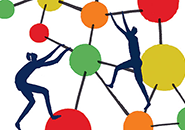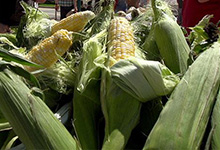Kevan Shokat has been trailing one killer after another since the early 1990s. The organic chemist and HHMI investigator at the University of California, San Francisco, has been investigating signaling pathways within a cell, domino chains of molecules that, when disrupted by a mutation, can trigger uncontrollable growth that turns an ordinary cell cancerous.
He began by trying to inhibit molecules at the front end of these pathways, but just over a decade ago, he moved down the chain and deeper into the cell, focusing on a protein called K-Ras. Normally, the protein is key to healthy cell growth. But when mutated, “it is the most frequently activated oncogene, the oncogene that is responsible for the cancers with the worst prognosis for patients,” Shokat says. And, he adds, it had proven completely resistant to attempts to inhibit it.
K-Ras is like a switch when it comes to cancer, and this molecule keeps the switch in the off position.
Kevan Shokat
That frustrating picture may be changing. Shokat has found a hidden pocket in a mutated, cancer-causing form of K-Ras that allows a drug molecule that his team built to bind to it. “K-Ras is like a switch when it comes to cancer, and this molecule keeps the switch in the off position,” Shokat says. Even better, he adds, the molecule only sticks in the pocket in the mutated form of K-Ras, leaving the normal form of the protein alone. Shokat and his team reported their findings in the November 28, 2013, issue of the journal Nature.
Multiple ways to inhibit the mutant may be emerging as other researchers are learning how to disrupt proteins that help mutant K-Ras encourage cancerous growth. The National Cancer Institute has seen enough recent progress to fund new work on the Ras family of oncogenes to the tune of $10 million. To move his team’s compound into drug development, Shokat has cofounded a company, Araxes Pharma, which is partnering with Janssen Biotech to improve the potency and stability of the compound.
K-Ras was identified in the 1980s. The mutant form is active in at least 20 percent of human cancers. It is especially dangerous in pancreatic and colon cancers, where it is mutated in 90 percent and 40 percent of cases, respectively. It is also mutated in 20 percent of non-small-cell lung cancers. Shokat’s team has been focusing on the most common form of these lung cancer mutations, a version of K-Ras called G12C.
Normal K-Ras signals cells to grow by binding to a nucleotide called GTP and helping transform it into another molecule called GDP, which stops the signal. Mutant K-Ras, however, doesn’t switch the complex to GDP, and it binds very strongly to GTP, forcing malignant, ongoing cancerous growth. “The mutant has its foot on the gas all the time,” says Shokat.
In G12C, an amino acid called cysteine is substituted for a glycine in one particular spot. Cysteine also has chemical properties that make it easy for another molecule—like a potential drug—to bind with it. The researchers screened 700 molecules over three years, and finally found one that fit tightly to the cysteine. When they examined the structure of the protein bound to the molecule, they learned that the docking occurred near a pocket no one had noticed. That pocket appears to be a crucial part of the K-Ras link to GTP, the “on” switch. Adding the new molecule kept the link from forming.

Stephen Fesik, who studies the structural biology of the protein at Vanderbilt University, says there are many positive things about Shokat’s approach, but a few concerns, too. “Kevan has identified a way to bind a molecule to mutant K-Ras and not the wild type, or normal, protein. That was very cool.” However, Fesik notes, researchers—including his own group—have had a very difficult time ensuring that drug candidates bind very strongly to the K-Ras complex. He’s also concerned that using cysteine as a target could create some toxic problems within the cell. Many cellular proteins have a free cysteine, he says, so a drug aimed at K-Ras could latch onto them as well and disrupt their normal function, harming the cell.
Shokat concedes that nothing is ready for the clinic yet. But he says his team has found ways of stabilizing the bond, and the cysteine approach he is using would not necessarily interfere with other proteins, only K-Ras. “We tested this,” he says, “by asking if the abundant protein albumin, which has multiple free cysteines, reacts with our compound—and it does not.” The compound he is working with also has a structure similar to a cysteine-reactive anticancer drug, called Ibrutinib (Imbruvica), which was recently approved by the U.S. Food and Drug Administration as a treatment for chronic lymphocytic leukemia.
Now, Shokat says, the search is on for singular features, like the G12C pocket, in forms of K-Ras that cause pancreatic cancer and colon cancer. He’s found vulnerability in one killer, he says. Time to go after the others.









